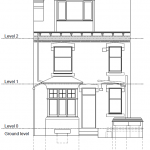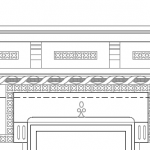Homeowners




What type of projects do you work on?
Whether you want to restore your home to its former glory, re-model, extend and modernise it, improve its energy efficiency, adapt a different building type to make it your home, or build a new home in a historic setting, I can help you achieve the home of your dreams.
I believe we are custodians of the historic and natural environments, tasked with protecting and enhancing it so that it can be enjoyed not only by us, but generations to come. As an architect specialising in heritage conservation and sustainability, I am committed to using my skills and knowledge to deliver a home that accomplishes these complex requirements, and deliver a home that both you and your community can be proud of.
I work on the following project types:
Existing houses
- Older houses (dating from the 1600s to 1930s)
- Houses that are listed (Grade I, II* and II)
- Houses in conservation areas (of any age)
- Houses in or near World Heritage sites (of any age)
Non-residential and new build houses
- Adaptation of other building types to create a house / houses
- New houses in conservation areas
- New houses near World Heritage sites


What architectural services do you provide?
Appointing an architect can be a daunting experience and it is understandable that many homeowners are uneasy about committing design fees to a project before they have fully understood how their needs can be met. I can work with you from when you have the very first seed of an idea or identify that something needs to change, all the way through to the completion of your project and its occupation. The Royal Institute of British Architects (RIBA) break this down into eight stages – Stages 0 to 7.
I can guide you through these stages, beginning with a free consultation so that we can assess our compatibility in working together. If we agree to proceed, I will offer you a low-cost Options Appraisal. This allows you to move the project forward to a point where you are ready to commit to appointing an architect (and any other design team members who may be required, such as a structural engineer).
How does it work?
When you are ready to make contact, I will arrange a free, half hour phone or video call consultation with you to discuss
- your initial ideas on the project scope, budget and timescale
- the architectural process as defined by the Royal Institute of British Architects (RIBA)
- which aspects of the RIBA process may be applicable to your project and how we might work together
I will confirm our conversation by email, and provide you with a resource pack which will help guide you through the project. I will also submit a fee proposal for my initial services. This might be for pre-project advice or for an Options Appraisal (RIBA Stages 7 and 0).
If you would like pre-project advice, for example about space planning, the historic environment, or sustainability and traditional materials (energy retrofitting, building / material re-use, waste / water reduction etc), I will give general advice on the options, themes and technologies you are interested in, as well as explanation of how these might be integrated in the historic environment. All advice will be confirmed in writing.
The Options Appraisal is a low-cost consultation during which I will work with you to consider the options available to you in more detail. It may include:
- Occupancy evaluation of building performance in use (Stage 7, if required)
- Preparation of your project requirements
- Consideration of your approach to heritage conservation
- Review of project risks and budget
- Confirmation of the option that best delivers your requirements
- Site appraisal
- Strategic appraisal of planning and conservation considerations
At the end of this stage, I will provide you with the Options Appraisal report and a fee proposal for carrying out the next three stages of work. The report will form the foundation for the project at RIBA Stages 1-3 covering development of the project brief, concept design and spatial co-ordination, the point at which a Planning Application and any necessary conservation-related consents can be submitted.
Once RIBA Stage 3 is complete, I can provide a further fee proposal for Stages 4, 5 and 6. Stage 4 covers the technical development of the design including submission for Building Regulations Approval, preparation of construction drawings, and co-ordination of the construction tender process. Stages 5 and 6 cover activities associated with the manufacture, construction and handing over of the completed building work such as the inspection of construction work and managing the building contract.
Fees
Your commitment to the work is limited to each fee proposal stage agreement so you can be confident that you will only pay for the architectural services you require. To provide reassurance of the overall cost of the service, I can estimate the fees at commencement of the project based on construction cost. The actual fee for each stage will be confirmed on completion of the previous stage however, to ensure the fee reflects the project size, scope and complexity as it develops.
The activities I will undertake are customised to your specific project so for example, it is not always necessary to commission all services at each stage. The fee for the agreed activities is fixed at each stage, but note that disbursements such as map acquisition, and fees payable to other organisations, such as the local authority may change. Full details are provided in each bespoke fee proposal agreement.
What else do I need to know?
Only qualified and registered architects are allowed to use the title ‘architect’ – the Architects Registration Board provides further information.
In addition, Chartered members of the Royal Institute of British Architects are entitled to use the letters ‘RIBA’ after their name. These architects are committed to providing the highest professional and ethical standards.
The Royal Institute of British Architects website provides a useful guide about finding, appointing and working with architects.
The Construction (Design and Management) Regulations 2015 place certain responsibilities on domestic clients. This will be discussed as part of the appointment process but you can also find out more information on the HSE website.
Historic England provides advice on the most common types of work to older houses which you may find helpful as you begin to think about your project.
